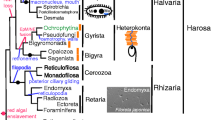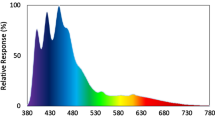Abstract
Intracellular symbiotic dinoflagellates are associated with the tropical scyphozoan Linuche unguiculata (Swartz, 1788) throughout all stages of the host's life cycle. During sexual reproduction, eggs are released in mucus strands that contain symbiotic dinoflagellates. Fertilization and development take place externally in the water column. Epifluorescence and transmission electron microscopy showed that unfertilized eggs did not contain intracellular algae, but that infection of the developing embryo was generally successful by the 128-cell stage (≃10 h after fertilization at 23° C). However, experiments with artificially provided Cellufluor-labeled algae demonstrated that older embryos and planulae could be infected by algae through at least 24 h post-fertilization, indicating that the L. unguiculata symbiosis represents a “semi-closed” system. This novel mode of symbiont acquisition results in most sexually-produced offspring becoming infected with maternally-transmitted algae during early development, but allows for acquisition of non-maternally-provided algae later in development. Most of the algal symbionts during the early stages of embryonic and larval development are located within ectodermal cells. This is in contrast to the other life-cycle stages of L. unguiculata (i.e., scyphistoma, medusa, ephyra), where symbionts are found within the gastrodermis of the host.
Similar content being viewed by others
References
Benayahu Y, Achituv Y, Berner T (1988) Embryogenesis and acquisition of algal symbionts by planulae of Xenia umbellata (Octocorallia: Alcynocea). Mar Biol 100: 93–101
Benayahu Y, Loya Y (1983) Surface brooding in the Red Sea soft coral, Parerythropodium fulvum fulvum (Forskal, 1997). Biol Bull mar biol Lab, Woods Hole 165: 353–369
Buddemeier RW, Fautin DG (1993) Coral bleaching as an adaptive mechanism. BioSci 43: 320–326
Colley N, Trench RK (1985) Cellular events in the reestablishment of a symbiosis between a marine dinoflagellate and a coelenterate. Cell Tissue Res 239: 93–103
Conklin EG (1908) The habits and early development of Linerges mercurius. Publs Carnegie Instn 103: 153–170
Costello J, Kremer P (1989) Circadian rhythmicity in the location of zooxanthellae of the scyphomedusa Linuche unguiculata. Mar Ecol Prog Ser 57: 279–286
Fadlallah YH (1983) Sexual reproduction, development and larval biology in scleractinian corals. Coral Reefs 2: 129–150
Farrant PA (1985) Reproduction in the temperate Australian soft coral Capnella gaboensis. Proc 5th int coral Reef Congr 5: 314–324 [Gabrie C et al. (eds) Antenne Museum-EPHE, Moorea, French Polynesia]
Hoegh-Guldberg O, McCloskey LR, Muscatine L (1987) Expulsion of zooxanthellae by symbiotic cnidarians from the Red Sea. Coral Reefs 5: 201–204
Kremer P, Costello J, Kremer J, Canino M (1990) Significance of photosynthetic endosymbionts to the carbon budget of the scyphomedusa Linuche unguiculata. Limnol Oceanogr 35: 609–624
Krupp DA (1983) Sexual reproduction and early development of the solitary coral Fungia scutaria (Anthozoa: Scleractinia). Coral Reefs 2: 159–164
Larson RJ (1992) Riding Langmuir circulations and swimming in circles: a novel form of clustering behavior by the scyphomedusa Linuche unguiculata. Mar Biol 112: 229–235
Mangan J (1909) The entry of zooxanthellae into the ovary of Millepora and some particulars concerning the medusa. Q Jl microsec Sci 33: 697–709
Mayer AG (1910) Medusae of the world. Publs Carnegie Instn 109: 1–735
Ortiz-Corp's E, Cutress CE, Cutress BM (1987) Life history of the coronate scyphozoan Linuche unguiculata (Swartz, 1788). Caribb J Sci 23: 432–443
Rahat M, Adar O (1980) Effect of symbiotic zooxanthellae and temperature on budding and strobilation in Cassiopeia andromeda. Biol Bull mar biol Lab, Woods Hole 159: 394–401
Richmond R (1981) Energetic considerations in the dispersal of Pocillopora damicornis (Linnaeus) planulae. Proc 4th int coral Reef Symp 2: 153–156 [Gomez ED et al. (eds) Marine Sciences, Center University of the Philippines, Quezan City, Philippines]
Rowan R, Powers DA (1991) A molecular genetic classification of zooxanthellae and the evolution of animal-algal symbioses. Science, NY 251: 1348–1351.
Sugiura Y (1963) On the life-history of rhizostome medusae I. Mastigias papua L. Agassiz. Annotnes zool jap 36: 194–202
Spurr A (1969) A low-viscosity epoxy resin embedding medium for electron microscopy. J Ultrastruct Res 26: 31–43
Swartz O (1788) Medusa unguiculata och Actinia pusilla. K svenska VetenskAkad Handl 9: 198–202
Szmant-Froelich A, Yevich P, Pilson MEQ (1980) Gametogenesis and early development of the temperate coral Astrangia danae (Anthozoa: Scleractinia). Biol Bull mar biol Lab, Woods Hole 158: 257–269
Trench RK (1983) Dinoflagellates in non-parasitic symbioses. In: Taylor FJR (ed) The biology of dinoflagellates. Blackwell Scientific Publications. Oxford, pp 530–570
Trench RK, Thinh L-v (1995) Gymnodinium linucheae sp. nova the dinoflagellate symbiont of the jellyfish Linuche unguiculata. The J Phycol 30: (in press)
Author information
Authors and Affiliations
Additional information
Communicated by M.F. Strathmann, Friday Harbor
Rights and permissions
About this article
Cite this article
Montgomery, M.K., Kremer, P.M. Transmission of symbiotic dinoflagellates through the sexual cycle of the host scyphozoan Linuche unguiculata . Marine Biology 124, 147–155 (1995). https://doi.org/10.1007/BF00349156
Received:
Accepted:
Issue Date:
DOI: https://doi.org/10.1007/BF00349156




